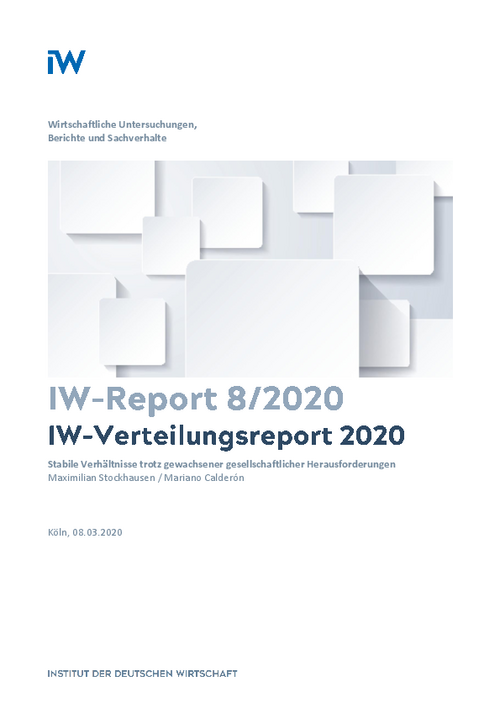How are income and wealth distributed in Germany? There is often no simple answer to this seemingly simple question, sometimes not even a clear one. Various social and structural changes have very different effects on the distribution of income and wealth: an ageing population, a tendency to live alone or an increasing share of the population with migration background along with economic changes amidst a deepening globalization and digitalization.

IW Distribution Report 2020: Stable Conditions Despite Growing Social Challenges
IW-Report

How are income and wealth distributed in Germany? There is often no simple answer to this seemingly simple question, sometimes not even a clear one. Various social and structural changes have very different effects on the distribution of income and wealth: an ageing population, a tendency to live alone or an increasing share of the population with migration background along with economic changes amidst a deepening globalization and digitalization.
Moreover, there are data and collection issues as well as statistical uncertainties resulting from the fact that only a part of the population is surveyed. Short-run developments should be treated with caution and not interpreted precipitously, since data must be regularly corrected, or facts reassessed. Long-run trends can be identified with greater certainty. However, breaks in time series in the available data sources also pose difficulties in some cases. Considering these challenges and limitations, we discuss the development of income and wealth in Germany since reunification. In addition, the most recent data from the Socio-Economic Panel (SOEP) are used to examine how relative income mobility in the life course, i.e. the financial opportunities for advancement of individuals from different income groups, have changed since reunification.
Essentially, data show that the current level of inequality in market and disposable household incomes is higher than in the 1990s. However, this is also the case for the average level of prosperity. For instance, average disposable household incomes rose by around 20 percent in real terms between 1991 and 2017. Especially the years since 2013 have been characterized by high real income increases for all income groups. Between the years 2013 and 2017 alone, average and middle incomes rose by approximately 7 and 9 percent in real terms, respectively, but even households in the lower 20 percent were able to record real income increases in this period.
A significant increase in the level of inequality in disposable household incomes can be observed between 1999 and 2005, a period characterized by high unemployment and diminishing opportunities for advancement, especially in eastern Germany. Since 2005, however, inequality in disposable household incomes has fluctuated at a virtually unchanged level of 0.29 Gini points and, according to current data, is not significantly higher in 2017 than in 2009. An interim high is now observable in 2013, although this is not significantly higher than in 2005 either.
The low-income rate (or at-risk-of-poverty rate) has also changed to a similar extent since reunification. Only in the last three years has the trend stabilized at a level of around 16 per cent. However, there are large differences in the low-income rate between Eastern and Western Germany and even larger differences between people with and without migration background. In recent years, the latter have increased rather than decreased in view of refugee migration. However, differences between Eastern and Western Germany decreases when taking price differences into account. Furthermore, unemployment remains by far the greatest low-income risk. When differentiating poverty risks according to age groups, however, there are sometimes considerable differences in the data sets (Niehues/Stockhausen, 2020).
The distribution of net wealth has developed similarly to disposable income: On the basis of the German income and expenditure survey (EVS), a long term increase in the level of inequality can be seen compared to the 1990s, which has not continued since the mid-2000s at the latest. In recent years, the distribution of net wealth turns out to be remarkably stable across different data sets. The SOEP and the data of the Deutsche Bundesbank show similar trends. In view of the available data, it is not possible to speak of a steadily increasing inequality in the distribution of net wealth at present, despite the uncertainties in estimating it. Estimation uncertainties include particularly the under-recording of assets at the top of the wealth distribution, but also of more widely dispersed assets such as life insurance or household inventory.
A look at income mobility over the life course reveals a mixed picture, with the lower 20 per cent having recently experienced higher levels of income mobility than after reunification. Around 60 per cent of people from the lowest income groups managed to move up into a higher group between 2009 and 2017. Between 1991 and 1999, 54 per cent succeeded in doing so. However, higher mobility of the lower 20 per cent is only evident in Western Germany. Compared with the post-reunification period, mobility for the lowest income group has tended to decline in the third period in Eastern Germany but is still higher than in the period between 2000 and 2008. Persistence at the upper end has also increased. However, a declining relative income mobility is not necessarily to be interpreted negatively. With broadly rising household incomes, as recently observed, the positions of individual households in the income hierarchy do not necessarily change, but their absolute level of prosperity can increase. At the same time, if mobility is viewed relatively, upward mobility of some results in downward mobility of others. Thus, lower mobility can also be an expression of greater stability in income levels, which many will certainly welcome.
All in all, Germany has recently showed a positive picture of economic development, which is reflected both in a largely stable distribution of disposable household income and net wealth. In view of the social challenges of recent years, this can be considered a success. The relatively high low-income ratios in Eastern Germany and of people with a migration background, which have recently stabilized, though at relatively high levels, remain to be viewed critically. One important task of economic and social policy must be to maintain and further expand employment subject to social security contributions when the economy cools down. At the same time, it must be possible to further improve the reconciliation of family and working life, for example by means of more flexible working time models or an even better provision of public and private childcare services. Capacity expansion of childcare services should not be realized at the expense of quality, given the high importance of investments in cognitive and non-cognitive skills of children at an early age, especially when it comes to children from lower-income household. These measures would not only help to further increase equality of opportunities in Germany but would also help to secure the potential of labor force in the future and for the future.

Maximilian Stockhausen / Mariano Calderón: IW-Verteilungsreport 2020 – Stabile Verhältnisse trotz gewachsener gesellschaftlicher Herausforderungen
IW-Report

More on the topic

A Macroeconomic Analysis of Wage-Price Spirals
The subject of this Analysis is the forms that wage-price spirals can take and how they influence macroeconomic stability and inflationary trends in Germany.
IW
IW Distribution Report 2023: Attitudes towards social mobility
Fundamentally linked to the social market economy is the idea that everyone has the opportunity for social advancement, regardless of their social background, and that children should be better off than their parents.
IW